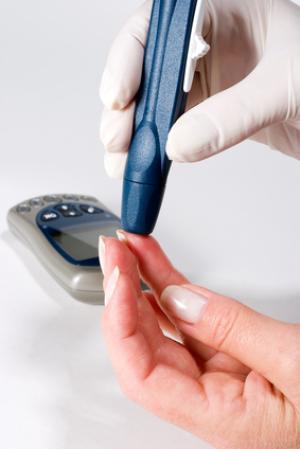美国2580万的糖尿病患者可能很快甩掉胰岛素日常注射的手刺法,梅奥诊所的内分泌专家Yogish Kudva和Ananda Basu共同开发出自动提供胰岛素的人工胰脏,可按患者病情提供胰岛素的相应精确剂量。
按照工作计划,Yogish Kudva和Ananda Basu要把关于日常行为如何影响血糖浓度的最新研究递交到圣地亚哥本月举办的 American Diabetes Association 会议上。
Kudva博士称,他们还没有用精密仪器检测出1型糖尿病患者的低强度机体活动对血糖浓度变化的影响,这一机体活动要模拟人们的日常行为。
最新一项发现是1型糖尿病患者饭后基本机体活动对血糖水平有明显作用。Kudva博士称:“你或许能预知这一结果,而我们想知道的是机体活动处于何种强度下,糖尿病患者血糖浓度才会发生明显改变。"
糖尿病患者饭后进行低强度的机体活动,血糖浓度与胰腺功能正常的健康人一致,而饭后久坐的糖尿病患者血糖浓度上升明显。
研究人员计划把以上试验结论整合到梅奥诊所正在开发的人工胰脏中,该人工胰脏是一个包括血糖监测仪、胰岛素自动注射仪、一系列监测机体活动仪和中央处理器在内的"闭环系统"。
人工胰脏的临床试验将在11月开展,大批相关病人作为试验对象接受有关饮食、锻炼和胰岛素注射的严格方案,试验信息将载入到决定胰岛素递送剂量的运算程序,这一运算程序可模拟机体对血糖浓度监测和反应的生理过程。
Kudva博士称,机体活动可提高胰岛素活性,进而降低血糖浓度,机体活动的实时监测以及对血糖浓度动态影响的模型是设计胰岛素自动投递系统的关键。
梅奥诊所Kudva博士和其他人员在各种糖尿病和肥胖症方面研究了近15年,合作开发出调控糖尿病人血糖动态平衡的算法程序和人工胰脏。
Basu博士将发表一项研究——胰脏功能健全的健康人早晨血糖浓度下降速度要比晚餐时快,表明胰岛素自然活动的昼夜模式。他建议进一步研究这一现象,并将该信息整合在驱动"闭环系统"的运算程序。
该研究由美国国立卫生研究院资助。(生物探索译 Pobee)

血糖浓度检测
生物探索推荐英文
Artificial Pancreas Being Developed to Ease Diabetes Burden
Abstract:The 25.8 million Americans who have diabetes may soon be free of finger pricks and daily insulin dosing. Mayo Clinic endocrinologists Yogish Kudva, M.B.B.S., and Ananda Basu, M.B.B.S., M.D., are developing an artificial pancreas that will deliver insulin automatically and with an individualized precision never before possible.
As part of this effort, Drs. Kudva and Basu will present their latest findings on how the mundane movements of everyday life affect blood sugar to the American Diabetes Association meeting this month in San Diego.
"The effects of low-intensity physical activity, mimicking activities of daily living, measured with precise accelerometers on glucose variability in type 1 diabetes had not been examined," says Dr. Kudva.
Among his newest findings is that even basic physical activity after meals has a profound impact on blood sugar levels for people with type 1 diabetes. "You would expect this result, but we wanted to know to what extent this phenomena would happen in people with type 1 diabetes," Dr. Kudva says.
Diabetics who engaged in low-grade physical activity after eating had blood sugar levels close to those of people with fully functioning pancreases. Those who remained sedentary after their meal, however, had elevated blood sugars.
The researchers plan to incorporate these findings into an artificial pancreas being developed at Mayo Clinic. The "Closed Loop System" under development includes a blood sugar monitor, an automatic insulin pump, a set of activity monitors that attach to the body and a central processing unit.
Clinical trials of the artificial pancreases are likely to begin in November with a handful of inpatient volunteers. Study participants will follow strict diet, exercise and insulin-delivery regimens in Mayo's Clinical Research Unit. Data will then be fed into an insulin-delivery algorithm, which mimics the body's natural process of monitoring and responding to glucose levels in the bloodstream.
"Physical activity enhances insulin action, hence lowering blood glucose concentration," Dr. Kudva says. "Real-time detection of physical activity -- and modeling of its effect on glucose dynamics -- is vital to design an automatic insulin delivery system."
Dr. Kudva and other Mayo researchers have spent nearly 15 years working on various aspects of diabetes and obesity. They are collaborating on the artificial pancreas and developing an algorithm that will afford patients the peace of mind to eliminate their daily routine of diabetes maintenance.
Dr. Basu will present findings that blood sugar levels decrease faster in the mornings in healthy adults than at dinner time, suggesting a diurnal pattern to natural insulin action. He proposes further study of this phenomenon and possible incorporation into the algorithm that drives the Closed Loop System.
The research has been funded by grants from the National Institutes of Health.







